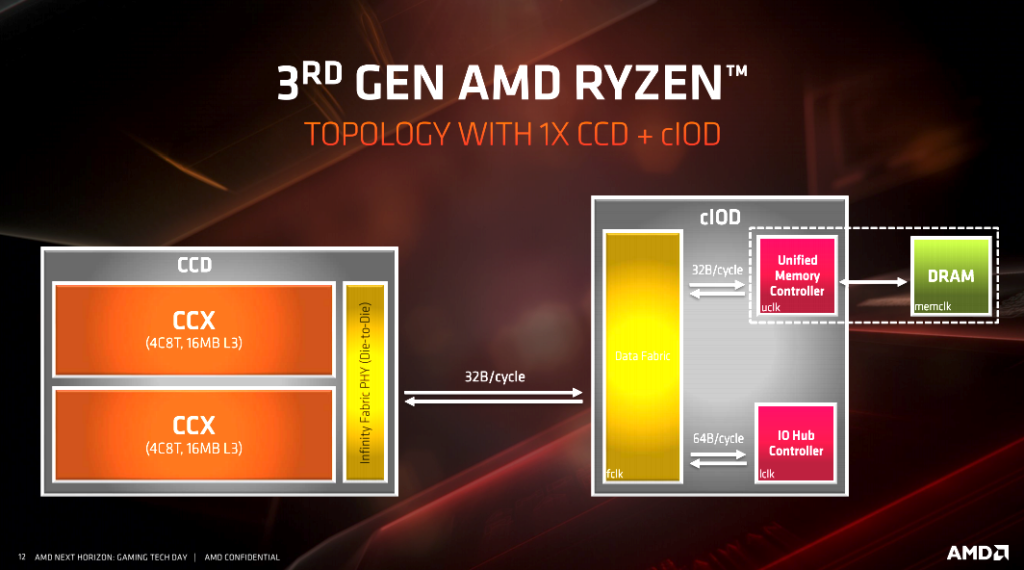CPU Design Overview
I won’t delve too much into the architecture of the CPU, as that’s a complicated subject which we’ve addressed before. For more information on the CPU’s architecture, check out our review of the Ryzen 9 3900X, which covers the architecture in detail.
Feature-wise, this CPU is identical to the rest of the Ryzen 3000 series as it uses the same architecture and chiplet configuration. If you’ve ever read up on these CPU’s before, you know that the CPU has an integrated PCI-Express controller and an integrated memory controller. The PCI-Express controller supports 24x PCI-Express lanes, all of which are PCIe Gen 4.0 compliant. 16 of these lanes are dedicated to PCI-Express graphics, 4x are dedicated to an integrated USB controller, while the last 4 are dedicated to storage. Motherboard makers do have the option to use SATA devices or split the PCIe lanes for 2x M.2 slots, but no one does this as far as I know. Therefore, 4x lanes are typically dedicated to NVMe storage.
The basic topology of the CPU is identical to the other single CCD Ryzen 3000 series CPU’s. It has only a single CCD or chiplet core die. Like other Ryzen CPU’s, it contains two CCX complexes within the single CCD. The other chiplet is the cIOD or IO Die, as its commonly known. You can also think of the 3600X as “half” of a Ryzen 9 3900X. An eight-core Ryzen 7 3000 series CPU has four cores per CCX and a total of eight per CCD. The Ryzen 9 3900X has only 3 cores per CCX and six per CCD. The 3600X is built the same way but only has one CCD.
Memory Support
When it comes to memory support, all of the Ryzen 3000 series CPU’s are exactly the same. AMD’s Ryzen 3000 series supports up to 128GB of DDR4 memory. Using two modules, AMD supports up to DDR4 3200MHz speeds natively. The memory controller supports dual channel memory mode operation.
As you can see by the table above, only speeds up to DDR4 3200MHz are supported officially. Using four modules, RAM speeds drop to DDR4 2933 and DDR4 2667MHz officially depending on the module configuration. Dual ranked modules do not run as fast as single ranked modules officially. Having said, that, your mileage may vary.
However, using only two modules, the Ryzen 3000 series CPU’s can clock RAM upwards of DDR4 3800MHz pretty easily. There are cases of people achieving speeds well beyond that with specific modules. However, using the RAM I have on hand, I’ve rarely ever been able to get a Ryzen 3000 series system to even POST at DDR 4 4000MHz speeds. Some configurations will, but of course, that means running the Infinity Fabric clock out of a 1:1:1 ratio with the memory and memory controller. Going beyond DDR4 3733MHz forces the Infinity Fabric clock to 1800MHz, and, creates around 9ns of additional latency. Latency that AMD states may be overcome with increases memory clocks and sub-timing adjustments.
The biggest problem with the Ryzen 1000 and 2000 series was memory compatibility. Intel systems can generally run nearly any module, often simply by turning on XMP and setting your memory voltage and clock speeds at most. With older Ryzen systems, things were much more complicated. Often RAM couldn’t be made to work at all, or if it could, you were forced to enter virtually all of the settings manually and often accept sub-par clock speeds that were well below what your RAM was rated for. Using four modules speeds of only DDR4 2400MHz were supported, which was less than desirable.
Thankfully, memory compatibility is something Ryzen 3000 series CPU’s have improved upon dramatically. I’ve generally been able to get all my test modules to work with Ryzen motherboards and CPU’s, regardless of their age. Some force me to set voltages and clocks manually but generally speaking, I can make them work almost without fail. In that regard, they aren’t too far off their Intel counterparts in my experience. However, things still do take a hit when using four modules as stated above and shown in AMD’s on the memory support table.


